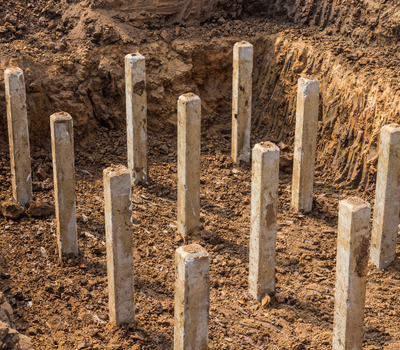


The construction industry in the UAE will grow by an estimated 4.2% throughout 2022.
Civil engineering is a crucial industry worldwide, and the demand for workers is always on the rise. To be a successful civil engineer, there’s a lot you need to understand. One of the many things you’ll need to learn about is pile foundations and how they’re used.
So what is pile foundation in civil engineering? Keep reading to find out.
Pile foundations are vital to the world of civil engineering. They are deep foundations that support a structure and help distribute the load at a given depth either by bearing or skin friction.
Pile foundations are typically formed as long, slender columns. There’s a range of types and materials available. The application determines what materials and classifications of piles are the most suitable for a project.
They’re ideal for large structures, especially where the ground below is unsuitable to resist uplift or excessive settlement.
One of the many jobs of civil engineers is knowing when pile foundations are necessary. While they’re not always essential, they can prove beneficial in many situations.
One of the main reasons to use pile foundations is that the ground requires extra stability. This can be if the soil is compressible or if the soil conditions are too poor to excavate it.
Sometimes the need is more related to the structure. If the loads from the structure aren’t uniform, pile foundations will help keep it stable. Sometimes other types of foundations may be too expensive or simply not feasible for a specific project.
Some other reasons to use pile foundations include:
In these situations, pile foundations are often the best choice. It’s important to remember that there are many different types, so understanding what’s best for what situation will help you make the right choice.

When developing a pile foundation solution, there are a lot of variables involved. The piles that are best for a project will depend on both the function as well as the material.
This classification relates to the design of the pile foundation. There are 5 main types available.
Sheet piles offer good resistance to lateral pressure, so they’re used when a lot of lateral support is needed. Some of the common applications include:
These are ideal for things like trench sheeting, cofferdams, and shore protection. Note that they don’t provide any vertical support.
These are suitable for transferring vertical loads from structures into the ground. When the soil itself provides little support, these can help bear the load.
The bottom of an end bearing sits on a layer of rock. The pile will often rest at the transition between a strong and a weak layer. You can multiply the bearing capacity by the area of the tip to get the total capacity of an end bearing pile.
Friction piles use a frictional force against the surrounding soil to transfer the load. These work with substances such as sandy soil and clay. This frictional force can apply to a portion of the pile or the entire length.
The capacity can be found by multiplying the safe friction force by the pile’s surface area. With these piles, a reasonable safety factor needs to be in place. The capacity can be increased by using a larger pile diameter, using more piles, or making the surface rougher.
These are typically used at close intervals and provide support by compacting the soil. They’re the only type of pile foundations that don’t carry loads directly.
The materials used for piles can determine factors like load capacity as well as resistance to things like erosion and corrosion. The installation process is also a factor when deciding on the material.
Timber piles are typically used when they need to go below the water level. They can be circular or rectangular and have a diameter between 12 and 16 inches. They usually have a length of around 20 times the top width.
Timber piles are economical and easy to install. They’re unlikely to be damaged and last for around 30 years. They’re also easy to remove if needed.
Note that they’re difficult to drive into hard soil and often need to be treated to ensure their durability. If you need shorter timber piles, it can be difficult to find straight ones.
Concrete piles are often reinforced with steel to make them more durable. They have good chemical resistance, and the quality of concrete piles is easy to control. Using concrete piles can also speed up the project if they’re cast and ready to go in time.
When a concrete pile is cast, it becomes very difficult to change it. They’re also not made as standard, so this can sometimes delay a project when getting started. Installation can be more expensive than other types of piles, and there’s a possibility of damage during this stage.
Concrete piles can also be cast in place. This is where the soil is bored, and a concrete mix is poured into place. This makes it easy to change the length and prevents any damage from occurring during installation. It does, however, require more control, and more storage space is needed on-site for the necessary materials.
These are typically hollow pipe or I-beam sections. The diameter can range from 10 to 24 inches and are most often 3/4 inches thick. This makes them easy to install, especially as they can penetrate harder soils more easily.
They can also handle heavy loads. On the downside, they could corrode and may deviate while being driven. They’re also one of the more expensive options.
Now you’re no longer asking, “what is pile foundation in civil engineering?” but may still have many more questions ahead of you. Being a civil engineer isn’t easy, but if you’re looking to get started or have experience and want something new, SAA Group can help.
SSA Group is a leading civil engineer recruitment agency. We currently have a wide range of positions (such as pile foundation jobs) in the UAE, which is becoming one of the most desirable places in the world to live. If you want to know more, click here to contact us today.